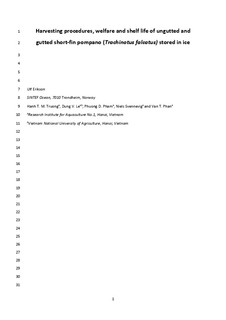Harvesting procedures, welfare and shelf life of ungutted and gutted shortfin pompano (Trachinotus falcatus) stored in ice
| dc.contributor.author | Erikson, Ulf Gøran | |
| dc.contributor.author | Truong, Hanh TM | |
| dc.contributor.author | Le, Dung V | |
| dc.contributor.author | Pham, Phuong D | |
| dc.contributor.author | Svennevig, Niels | |
| dc.contributor.author | Phan, Van T | |
| dc.date.accessioned | 2020-02-17T09:47:31Z | |
| dc.date.available | 2020-02-17T09:47:31Z | |
| dc.date.created | 2019-05-06T17:22:28Z | |
| dc.date.issued | 2019-01-01 | |
| dc.identifier.citation | Aquaculture. 2019, 498 236-245. | nb_NO |
| dc.identifier.issn | 0044-8486 | |
| dc.identifier.uri | http://hdl.handle.net/11250/2641899 | |
| dc.description.abstract | Despite the possible increase in use of anionic polyacrylamide (APAM) in enhanced oil recovery operations, very little relevant information regarding ecotoxicity exists. The current study assessed acute and sub-lethal toxicity in sensitive early life stages (ELS) of Atlantic cod (Gadus morhua) exposed to 200 kDa APAM under controlled laboratory conditions. Two experiments (screening and long-term study) were conducted covering ecologically relevant endpoints (survival, hatching, growth, deformations, respiration and heart rate) in fish developing through embryogenesis, hatching, yolk-sac larvae stage and the first feeding period. The screening experiment was an 8-day exposure of embryos, whereas in the long-term experiments embryos and developing larvae were exposed continuously for 23 days. In the screening experiment, a significant reduction in embryonic heart rate was observed during exposure to 150 and 1500 mg APAM/L. However, we observed no effects on fitness-related endpoints (survival, hatching and growth) at concentrations up to 1500 mg L−1 APAM. Also, for the long-term exposure from late embryo to first feeding larvae stage, we observed reduced heart rate at 125 mg L−1. No consistent responses on survival, growth or respiration were observed except for the highest concentration tested (6000 mg L−1). Dispersion modelling based on expected and relevant discharged polymer concentrations and durations showed that predicted environmental concentrations were orders of magnitude lower than the concentrations tested in our experiments, indicating that 200 kDa APAM will have a limited probability of causing fitness-related effects on Atlantic cod ELS. | nb_NO |
| dc.language.iso | eng | nb_NO |
| dc.publisher | Elsevier B.V. | nb_NO |
| dc.rights | Attribution-NonCommercial-NoDerivatives 4.0 Internasjonal | * |
| dc.rights.uri | http://creativecommons.org/licenses/by-nc-nd/4.0/deed.no | * |
| dc.subject | Shortfin pompano | nb_NO |
| dc.subject | Harvesting | nb_NO |
| dc.subject | Stress | nb_NO |
| dc.subject | Welfare | nb_NO |
| dc.subject | Ice storage | nb_NO |
| dc.subject | QIM | nb_NO |
| dc.subject | TBC | nb_NO |
| dc.subject | AQUI-S™ | nb_NO |
| dc.title | Harvesting procedures, welfare and shelf life of ungutted and gutted shortfin pompano (Trachinotus falcatus) stored in ice | nb_NO |
| dc.type | Journal article | nb_NO |
| dc.type | Peer reviewed | nb_NO |
| dc.description.version | acceptedVersion | nb_NO |
| dc.source.pagenumber | 236-245 | nb_NO |
| dc.source.volume | 498 | nb_NO |
| dc.source.journal | Aquaculture | nb_NO |
| dc.identifier.doi | 10.1016/j.aquaculture.2018.06.085 | |
| dc.identifier.cristin | 1695908 | |
| cristin.unitcode | 7566,2,0,0 | |
| cristin.unitname | Sjømatteknologi | |
| cristin.ispublished | true | |
| cristin.fulltext | postprint | |
| cristin.qualitycode | 1 |
Tilhørende fil(er)
Denne innførselen finnes i følgende samling(er)
-
Publikasjoner fra CRIStin - SINTEF Ocean [1387]
-
SINTEF Ocean [1461]

